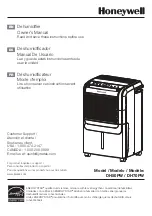
For advice on the safety and suitability of this
equipment contact your local HSS Hire Shop.
Keep children, animals and bystanders away from
the work area.
Never use this equipment if you are ill, feeling
tired, or under the influence of alcohol or drugs.
This equipment should only be used by a
competent person who has read and understood
these instructions.
Always transport, operate and store the unit in an
upright position,
never lay it on its side.
When siting the unit, consider the floor surface.
Avoid placing the unit on carpet, as the carpet may be
damaged.
Check the condition of the equipment before use.
If it shows signs of damage or excessive wear, return it to
your local HSS Hire Shop.
Most HSS dryers plug into a standard 240V, 13A
power socket. However, 110V models
(with a round,
yellow plug)
must be supplied from a 110V
generator, or from the mains via a suitable
transformer.
If the equipment fails, or if its plug or lead gets
damaged, return it.
Never try to repair it yourself.
Keep the flex out of harm’s way, extension leads
should be fully unwound and loosely coiled, away
from the equipment.
Never run them through water,
over sharp edges or where they could trip someone.
Using electrical equipment in very damp or wet
conditions can be dangerous.
To reduce the risk of electric shock, use a
suitable RCD
(Residual Current-Operated Device)
available from your local HSS Hire Shop, or power 240V
(Not 110V) equipment from a power circuit with a
built-in RCD.
ELECTRICAL SAFETY
GENERAL SAFETY
If the equipment fails, or if its plug or lead gets
damaged, return it.
Never attempt to repair it yourself.
Never carry or pull the equipment by its flex.
Ensure the machine and power socket are
switched OFF before plugging into the power
supply and when making any adjustments.
A dehumidifier works by drawing warm moist air
through the unit, cooling the air to a temperature where
the moisture will condense. The moisture is then
collected ready for disposal via a hose or water container.
If the dehumidifier is being used after flood
damage, remove curtains, carpets and furniture
from the room –
for water logged carpets use a wet
pickup vacuum, ask at your local HSS Hire Shop
for advice.
Set the unit up
on a firm level surface, either
in the
middle of the room or facing any specific
wet patch.
If the unit is NOT fitted with a built in water
collector, direct the drain hose into a suitable
container or into a drain, via a hosepipe.
Ensure hoses are kink-free and below the level of
the dryer’s outlet along their entire length –
otherwise water extracted from the air will back up and
flood the dryer.
If the hose is to be directed into a separate
container, you must seal the top of the container
and around the hose with cling film –
otherwise the
water collected will re evaporate into the atmosphere
and slow down the extraction process.
All windows and doors must be fully closed,
and if
possible, tape up all joints to stop air from outside
entering the work area.
Allow the unit to settle for 1 hour,
after moving, or
before switching ON.
Plug the unit into its power supply, switch on and
leave it to get on with job.
However,
if fitted with a humidity control, turn the
control fully anticlockwise, plug the unit into its
power supply, then turn the humidity control
clockwise
until you hear the motor start.
If using a WARM AIR DRYER…
Set the unit up as for an ordinary dryer then turn
on the fan and select the required heat setting–
HEAT 1 for low; HEAT 2 for high.
Note that the HEAT 2 setting won’t work unless
the HEAT 1 switch is ON, and neither heater will
work unless the FAN is ON.
GETTING STARTED
If the machine is draining into a container, empty
this at regular intervals.
At the same time,
check on
the amount of water the machine is extracting
from the air.
There will always be a certain amount of
moisture collected because air naturally contains
moisture, but the amount will become negligible as the
room dries out.
If the unit has a built-in water collector, the motor
will automatically stop when full. This will be
confirmed if the ‘full tank’ lamp is illuminated.
To empty the collector, pull open the rear cover
and carefully remove the container. Once emptied,
carefully replace the container and ensure the rear
cover is closed securely.
BASIC TECHNIQUES
Siting an RCD
When used with a transformer an RCD will only
protect the user if fitted between the transformer and
the tool being used.
An RCD fitted between the power supply and the
transformer only protects up to the transformer.
Tool or
Lead
RCD
Transformer
Supply
Humidity
Control
Rear Cover
Water
Container
Power ON
Lamp
Water
Container
Full Lamp
Humidex




















